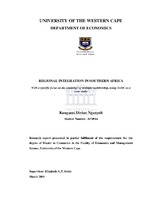| dc.description.abstract | Regional integration dates back to the work of Jacob Viner who distinguished between the terms ‘trade creation’ versus ‘trade diversion’ in the context of the gains from customs unions. Since then regional trade agreements have been entered into all over the world and almost all members of the World Trade organisation are members of at least one trade agreement. Moreover, individual countries have also signed free trade agreements with countries not involved in the same regional block. Also, in this era of globalisation, the demands of the WTO often work against progress to deeper integration in the specific regions.Despite their relatively weak performance, Africa is home to the largest number of regional trade agreements where member states of a particular regional trade block also
belong to anther regional block or have signed preferential trade agreements with third countries. This phenomenon of multiple memberships is particularly true of trade blocks in Southern Africa. For example, the DRC, Malawi, Angola, Madagascar, Mauritius, Swaziland, Zambia and Zimbabwe are members of SADC, but also full members of COMESA.This report presents a study on regional integration in Southern Africa and specifically focuses on the presence of overlapping memberships in Southern and Eastern Africa. It provides a descriptive overview of COMESA, the EAC, SACU and SADC where member countries of the former blocks are also members of SADC, but focuses specifically on the problems and challenges due to multiple memberships, such as different approaches to regional integration, problems related to different rules of origin and non-tariff barriers, amongst others.Thereafter the focus is on SADC as regional trade block. The report discusses the establishment of SADC, its main aims and economic performance since its inception and also the special problems and challenges, such as the multiple memberships of its members. Finally South Africa’s preferential trade agreement with the European Union is discussed as example of how multiple membership impact on the development of trade relations between member countries of SADC. | en_US |

